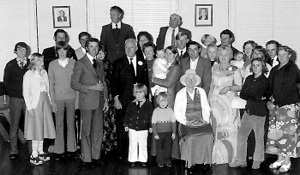The Life and Times of My Parents
- by Louise Frazer
My mother, Elizabeth May Ludington, was born on 10 November 1911 in the Brancaster Nursing Home, Scone, the firstborn of the two children of Arthur George and Sarah Louise Ludington, (nee Vine). At this time they lived at "Sundown" owned by G.M. Campbell.
When Mum was seven years old the family moved to Blandford where her father worked on a property owned by Gran's Uncle, Ben Hibbs. The famous Wallabadah Rock stands on this property. After eighteen months at Blandford they returned to "Sundown" to work for George Campbell. Shortly after this George Campbell bought "Goggs Top" so the Ludington family, including six months old baby, Joseph James, born on 27 May 1920, moved to "Goggs Top".
Some time later J.F. and A.S. Vickery had bought Glenrock Station. Glenrock included a number of outstations such as "Sundown", "Goggs Top", "Grass Tree", "Bralgo", "Fairview", "Glenroy" and "Dunmore". The Ludingtons continued to live at "Goggs Top" but Mum's father worked on all the Glenrock properties which were managed by H.M. Howard.
Mum had little formal schooling. There was a school at Glenrock but this was twelve miles from where they lived. Mum's auntie and uncle, Fred and Elizabeth Ludington worked on one of the other stations which was a mere five miles from Glenrock so it was decided that mum should live with them during the week so that she could ride a pony to Glenrock School. After about three years Fred and Elizabeth left Glenrock so Mum's formal education ceased. A few years later a young man with a very interesting background arrived at Glenrock as the offsider to a bullock driver named Harry Eagle. His name was Joseph Alderson.

Joseph Alderson was born in Nanchang Kiang Si in China on 13 January 1911, the son of English missionaries. He was educated at Red Croft School which was established to educate the children of English speaking missionaries. Dad sailed to Canada when he was thirteen but his parents remained in China. In 1924 he was living with a Mrs May Nands in Victoria, Canada where he attended school for nine months. On 6 July 1925 he sailed for England on the SS Canada. He attended Mount Exoder School for six months before leaving school to work in a soap factory.
At the age of fifteen Dad decided to migrate to Australia. On 6 August 1926 he left England on board SS Barrabool and he arrived in Sydney on Thursday, 24 September 1926. Two days later he caught the Glen Innes Mail Train to take up work at the Glen Innes Experimental Farm. He stayed there for four months but on 5 January 1927 he com-menced work for Harry Terbutt at Eulah Creek near Narrabri. His first job was sewing wheat bags but undoubtedly, the young English boy would have spent a good part of his sixteenth birthday on 11 January lumping wheat bags in the heat of an Australian summer. Dad worked for Harry Terbutt until 2 February 1929.
As mentioned earlier, Dad arrived at Glenrock Station as the offsider to bullock team driver, Harry Eagle, some time in 1929. The Great Depression commenced in 1929. Within months one third of the Australian workforce was unemployed. Dad would have been pleased to gain work on Glenrock Station. As a station hand he had to milk the cows, cut firewood, butcher the station meat and run the horses in on the quiet old horse which was kept in the night paddock for this purpose but eventually he learned the full range of station work such as fencing, shearing and horse breaking which was to be of so much value to him when he bought his own property.
At this time quite a number of people lived at Glenrock and its outstations. Social life consisted mainly of dances and tennis but station people often enjoyed trips to various places on the Hunter on the Glenrock Bus, a station truck with seats on the open tray In this way the Glenrock Football Team and its supporters travelled to matches. Before long Dad met young May Ludington at "Goggs Top". They soon fell in love.
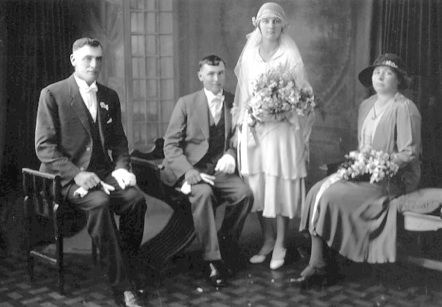
They lived at the Red House at Glenrock for about six months before moving to "Grasstree" just before their first child, Daniel, was born in 1933. I was born on 11 June 1935. Then followed Edna Joyce on 18 February 1938, Wilhelmina Revelry on 20 January 1940 and Janice May on 6 December 1941. We were all born in the Brancaster Nursing Home, Scone.
Among Mum and Dad's most precious possessions were gifts brought to Australia by Dad's parents when they arrived from China in 1935. They brought a Chinese dinner set, cushion covers, table linen, salt and pepper pots, a set of Chinese children's clothing for my brother, Daniel. They returned to China as missionaries. Grandma Alderson died in China in 1943 and Grandfather Alderson made his way to Australia via Calcutta, despite the War and the Japanese occupation of most of South East Asia. He came to stay with us for a while and then he moved to Brisbane.
Station Hand to Station Owner.
In 1934 Dad was twenty three years old, married with a young son and he had travelled the world. He felt it was time to become his own boss. "The Willows" was a property of 4200 acres on the Barnard River, adjacent to Glenrock. It was for sale for the princely sum of four hundred pounds. Dad was keen to buy it. H.N.Howard, the son of the manager of Glenrock put up two hundred pounds, my grandfather, A.G. Ludington, put up one hundred pounds and Dad put up one hundred pounds. They became the proud owners of "The Willows". Some time later Dad bought out his partners and became the sole owner.
"The Willows" was largely undeveloped. It was Eastern fall country stretching from the Barnard River up the mountains to Tuglo Creek. The Barnard River portion was generally referred to as "The Willows" and the higher portion as "Smoky Swamp". Down on the Barnard River there was a small slab house with an iron roof. Room dividers consisted of hessian with newspaper pasted on it. There was an open fire in two rooms, the kitchen and the living room. There were two bedrooms and a veranda along the back. On the end of the veranda was a small room where Dan slept sometimes.
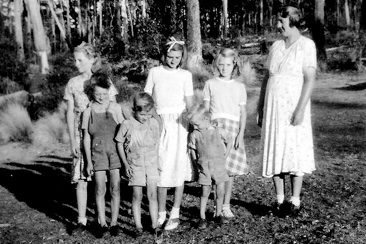
When the fence was complete we did not return to the hut down on the Barnard River as it was too isolated. "Smokey Swamp" became our permanent home. Mum and Dad set about improving our living conditions. Using the bark that they had saved from the trees that Dad split for posts they built three bark huts. Mum and Dad's hut had an iron roof and bark sides. The
older children slept in another small bark hut and a third one was used as a living area.
Our beds were made from four stout posts dug into the bare earthen floor. Poles were attached to these posts and rabbit netting was nailed to the poles. On this netting was placed a sack filled with corn husks to serve as a mattress. It sounds rather primitive but it was very homely. Mum always had a flower garden between the huts.
The larger hut was a living area, consisting of a kitchen and dining area. It had a fireplace right across one end with mud hobs up each side for us to sit on. Water was heated in a four gallon kerosene drum which hung from a chain over the fire. Bathing was done in a large round tub with two handles on it that was placed in front of the fire. Also hanging from the bar above the fire was a two gallon meat boiler for boiling corned beef. Almost all the home killed meat was corned as there was no refrigeration. Mum used a variety of camp ovens for baking bread, making dampers and cakes and for cooking a baked dinner. She made the best rabbit curry and rice. Kangaroo tail stew was another of her specialties. Our favourite dessert was golden dumplings.
Living room furniture was all home made. We gathered around a slab table that sat on blocks of wood. More blocks served as seats. Half the floor of the living room was slab, the other half dirt that was swept to keep it hard and clean. Obtaining water for the house was always a problem. Dad dug a well eleven feet deep some three hundred yards from the house. It was at the head of a little gully and it provided beautiful water.
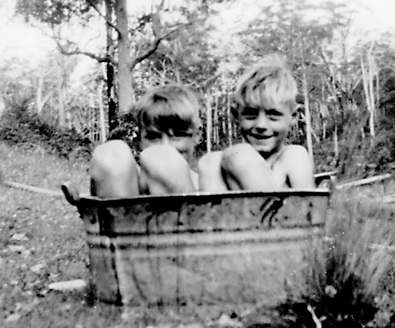
We carried the water from the well to the house with a pole over the shoulder and a kerosene tin on each end. Once mum killed a snake at the well and it fell into the water. We had to bale the well until it was empty to get the dead snake out.
We were a long way from medical help at but we all managed to survive. On one occasion Dan was swinging a mattock and I got in the way. I finished up in bed with a black eye and a wound above the eye that is still visible. While in bed we had our first snowfall but Mum would not let me out of bed to see it.
Mum gave birth to her second son, Jason, in one of our bark huts on 23 September 1943. Dad was away shearing on Glenrock Station when Mum went into labour. Dan and I at ten and eight were doctor and nurse for Mum while the little kids slept.. We lit the fire to heat up the water to bath our newborn brother and we warmed Mum's feet with a flat iron that we had placed before the fire. Next morning Dan rode over to Mrs Hogno's place some five miles away to get help. Mrs Mogno came over to look after the younger children until Grandma Ludington arrived. Mum had two more sons at "The Willows", James Dale, born on 22 July 1945 and Francis Phillip 27 July 1948. Dad's sister, Flo, a qualified midwife, assisted on these occasions.
Bush fires were a constant problem in the mountains during the hot summer months. When the bark rooves began to smoulder Mum lifted one of us up onto the roof with a bucket of water to douse the flames. After he Hognos who we called Auntie Lou, Harry and
Albert, were burnt out in a bush fire they arrived at our place with just the clothes they stood in. Mum and Dad lent them clothes so that they could drive into town to buy some more.
Certain routines developed at "Smokey Swamp". Monday was washing day. The clothes were boiled up in a kerosene tin over an outdoors fire. Three tubs were set on a platform, one for washing, one for rinsing and one with blue to make the whites white. Mum used a washboard to scrub the dirty clothes. The clothesline consisted of fencing wire strung between three trees. Forked saplings were used as props to keep the washing up off the ground.
Water had to be carried up from the well for the washing and for household use. The washing water was used to help water the garden. Mum loved flowers and she had dahlias, foxgloves, gladiolus, sweet peas and roses growing as well as vegetables and fruit trees.
Dingoes made sheep farming difficult. In 1944 they were killing so many of our sheep that Dad decided to sell all but about a dozen killers. I can still recall a night when Mum was home alone with her six children. The sheep were in a small paddock between the huts and the well. The dingoes came right down to the sheep and their howling made us shiver. Dad had hung a bell around one of the sheep so that we would wake up when they were disturbed. When we heard the bell ring Mum would go out into the dark and beat a kerosene tin with stick to frighten them off.
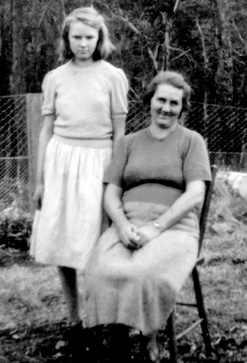
Although we had no close neighbours we still had visitors and on occasions we visited our neighbours. About every three months Mum would saddle up enough horses for us all to visit the Hognos who at five miles were our closest neighbours. At this stage she had seven children but with three children to a horse we managed the trip with much excitement. The neighbours shared the task of making the long trip to Tamworth to pick up groceries. Dad, Harry Hogno and Harry Nairn shopped for each other. When it was Dad's turn he made the trip down to Tamworth in the Packard.
When a visitor arrived there was much excitement. Everyone who passed by stopped for a cuppa and a chat. A regular visitor was Johnny McInnes who rode over from Glenrock every Saturday with the mail. He was a bachelor so he was happy to stay until Sunday night. Johnny and Mum and Dad played cards every Saturday night. Johnny always bought lollies for the kids and his unused food coupons for Mum.
Some time after this Mum used to earn a little extra money by delivering the mail which at this time was bought out from Niangala. Every Saturday morning she set out on her pony with the mailbags hanging down each side. It was a
thirty four mile round trip as she delivered mail to "Cowsby","Eagle Grange", "The Willows" and Quinns. I did the shorter trip to Hognos at "Forest Lodge". We were paid eighty pounds per year for delivering the mail.
When we were growing up Dad was away a lot as he used to go away working to help support his growing family. At first he shore at Glenrock but later her shore for the shearing contractors, Grazcos. His shearing trips took him well into Queensland. He also went away lumping wheat in the summer. Sometimes he was away for three months at a time. When he was away Mum sat us down every Friday night to write to him.
The nearest school to our place was at Niangala, twenty five miles away so we all did correspondence lessons.
The lessons came from the Correspondence School at Blackfriars in Sydney. The lessons used to arrive each week in the mail and we packed them up and sent them back when they were completed. We even had Sunday school by correspondence.
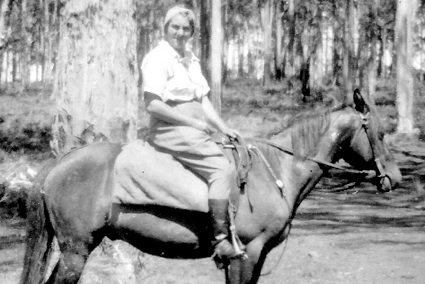
Christmas at "Smokey Swamp" was always an exciting time. I remember one Christmas when we all went through Quinns to the Tuglo Creek. Mum cooked pork and chicken and bread and prepared the tomatoes, lettuce, onions and tinned beetroot and put them in a "wallet", a wheat bag sewn at both ends with a hole cut through it on one side. We also used the wallet when delivering the mail. The loaded wallet fitted neatly over a saddle. We all climbed onto our horses and set out. Old Bill Gibbs who lived on the Tuglo came along too. The trip went well except that the horse that Janice and Rev were riding went under a low branch and scraped them off.
At other Christmases we would go to Grandma at Norley or Rosgale in the Packard car that Dad had bought. The big kids piled into the dickie seat while Mum, Dad and the little kids sat in the front. We always got sick. One time we had to take the dogs too and they also got sick. After that Dad left them at home and Old Bill Gibbs rode over to feed them while we were away. One day he arrived over to feed them the day after we got home. He'd made a big damper to feed to them but the dogs didn't get the damper. Old Bill was a strange man. He didn't like women and children but he was a good friend to Dad. He had a map of America tattooed on his chest, although we never got to see it. He had small tats on his fingers.
Mum and Dad's extraordinary life at "The Willows" came to an end in 1957. The older children had left home and Mum was keen to get the three younger boys into school so they sold "The Willows" and bought a small property, "Savannah", on Porcupine Lane, Kootingal. At last Mum had running water and electricity. To celebrate their move to Kootingal they had their ninth child. Dorothy Lynette was born on 22 August 1959, already an auntie to six nephews and nieces. Growing up at "The Willows" had a profound influence on us all and we take every opportunity to go camping back in that little bit of paradise where we were raised.
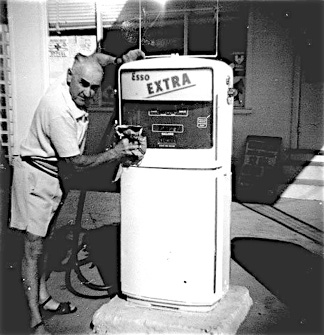
Dad developed cancer late in 1981 and he passed away in 1982. Mum stayed at Somerton for a few months after Dad died. My son, Tony, drove out to visit her every Wednesday and stayed the night. He enjoyed the delicious tea that she cooked and the good chat they had. No doubt he listened incredulously to her stories about life at "The Willows". Later that year she sold "Cedar Hill" and bought her present house at 15 Jill St Tamworth. Garry stayed with her for a while as this was the first time that she had ever lived in town.
Mum enjoys retired life, particularly the visits from her family. She uses the skills that she developed in those Saturday night card games at "The Willows" by playing cards at the Workman's Club.
When she was young her handicraft skills were a necessity to keep her children clothed. Now she uses these skill for her own enjoyment and for the benefit of her children and grandchildren. Among my daughter, Debbie's, proudest possessions are the crocheted swans that Mum made to decorate her wedding table. She also crocheted a beautiful gown for her great grandson, Aaron.
Mum is known and loved by her many grandchildren and great grandchildren for her good fun and good cooking. Recently, Brock and Ashlee had a cool afternoon teaching Grammie to play one of their games.
People today would not want to live the life my parents lived, but they had a good life and provided a great atmosphere for us children to grow up in. We made our own fun and we worked hard but we had the best parents in the world. Hard work never killed anyone. Just look at our Mum and our Grammie as she approaches her ninetieth birthday.
